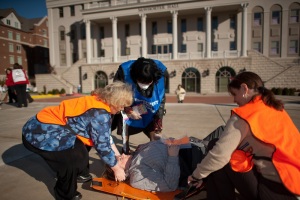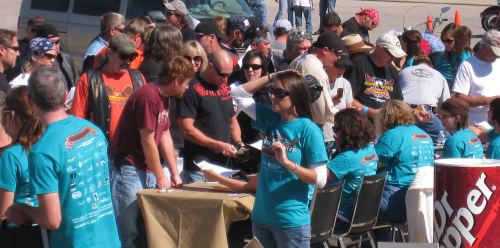 The disaster simulation drill featured as part of last month’s Tennessee Simulation Conference cosponsored by the Belmont University School of Nursing was featured recently in a Nashville Medical News article.
The disaster simulation drill featured as part of last month’s Tennessee Simulation Conference cosponsored by the Belmont University School of Nursing was featured recently in a Nashville Medical News article.
The article can be accessed directly at the Nashville Medical News website, but is also included below.
Collaborations and Conferences Push the Emerging Model
By: SHARON H. FITZGERALD
The scene would have been horrifying, if not for the posted signs that read “Disaster Drill in Progress.” Victims covered in faux blood were scattered on Belmont University sidewalks, stairs and lawns last month as nursing faculty from academic and hospital settings across Tennessee learned how such simulations better help their students learn.
The event was the third-annual Tennessee Simulation Conference, called “Practice, Practice, Practice! Patient Safety and Provider Performance,” held at Belmont’s College of Health Sciences & Nursing. Belmont boasts the Health Care Simulation Center, which has been recognized as a Laerdal Center of Education Excellence. That’s simulation education’s gold seal of approval. The two-day conference on Nov. 4-5 was preceded on Nov. 3 by a pre-conference at Vanderbilt University where participants new to simulation education learned the basics of setting up simulation programs at their institutions.
Just what is simulation education anyway? According to Beth Fentress Hallmark, PhD, RN, who is Belmont’s director of simulation, “A simulated clinical experience is anything that is not real. I hate to say that, but there are so many different components to it, from the actual pre-work that students have to do, to the simulation where they’re working in the lab or with a standardized patient. Because simulation is so new, we are really trying to define some of those terms.”
A “standardized patient” is an individual trained to play the role of someone who is ill or injured and that can certainly be a valuable learning tool. Yet, simulation may also be as simple as a nurse learning to administer an injection by substituting an orange for an arm. “It’s not just electronic simulators that we’re talking about,” Hallmark said, adding, “The most important portion of simulation is really the debriefing and the reflective thinking, where you sit around the table and you ‘unpack’ everything you’ve done.”
The seeds for the Tennessee Simulation Conference were sowed in 2006, when nursing education advocates across the state launched a full-fledged effort to apply for grant funding, Hallmark explained. They were successful, and the first conference at Belmont, entitled “Empowering Nurse Educators,” was held in 2008. Funding has come from a variety of sources, including the Community Foundation of Tennessee, the Tennessee Center for Nursing, Belmont, Vanderbilt and Austin Peay State University. Another financial source has been a national initiative by the Robert Wood Johnson and the Northwest Health Foundation. Called Partners Investing in Nursing’s Future, the national strategy was designed to establish a stable, adequate nursing workforce.
Today, the Tennessee Nursing Clinical Simulation Center is a website collaboration designed to help Tennessee nurse educators access the latest simulation resources. The site includes links to other websites, conferences, newsletters, presentations, journals and books, offering an in-depth look at what is practiced in the world of simulation today.
According to the website, “In today’s world of healthcare, we have learned simulation provides the learner a place safe from patient harm, helps the learner to increase confidence, and can provide the educator a means to make things happen, unlike clinical experiences. Educators are also learning that simulation education provides a format to teach teamwork.”
In fact, Hallmark’s presentation at last month’s conference focused on the importance of interdisciplinary cooperation in simulation education. “Not only is this going to be nursing, but we’re expanding this to include all disciplines. I’m working with physicians, EMTs, respiratory therapy, allied health, from the very top to the very bottom of the healthcare realm,” she said. She pointed to studies that now stress educating nurses “interprofessionally and not in those typical silos because the medical errors continue to occur.”
Still another Tennessee initiative is the new Tennessee Simulation Alliance, which held its inaugural meeting on Oct. 11 and met again in conjunction with the recent conference. Hallmark is the alliance’s program director, and she said the collaboration is multidisciplinary and involves healthcare professionals working together to ensure improved patient safety and the use of quality simulation scenarios. The alliance plans to partner with academia, industry, government and healthcare providers.
“In surgery, there’s still an increase in wrong-side surgeries or wrong-site surgeries. Isn’t that awful? We really feel like simulation is one way we can help with safety and communication and make sure that we are providing education for students before they get to the acute-care arena,” she said.
Hallmark said ongoing projects in Tennessee to further simulation include:
* Continued faculty education,
* An online “clinical placing system” database to help nursing schools find available simulation units they might use in hospitals, long-term care facilities and other institutions.
* Development of current nurses on a unit to act as clinical instructors.

